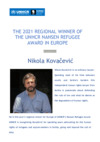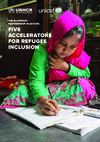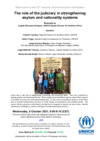Ethiopia: Somali refugees to be relocated away from border
This is a summary of what was said by UNHCR spokesperson Jennifer Pagonis – to whom quoted text may be attributed – at today's press briefing at the Palais des Nations in Geneva.
In Ethiopia today (Friday), UNHCR teams are expected to start relocating a group of 500 newly-recognized Somali refugees who fled from renewed conflict in strife-torn south and central Somalia over the last year. They have been staying around the Kebribeyah area, near the Somali border in eastern Ethiopia and are being relocated to a re-opened UNHCR camp at Teferi Ber.
The refugees are part of a group of 4,000 Somali refugees who have recently been granted refugee status by UNHCR and the government's Authority for Refugees and Returnees Affairs (ARRA). An estimated 7,000 additional Somalis who also claim to have fled fighting and insecurity in Somalia, are waiting to be screened at other sites in eastern Ethiopia.
The new camp site at Teferi Ber, some 120 km north of Kebribeyah, was formerly a UNHCR camp which in the 1990s hosted some 49,000 mainly Somalis refugees who had fled fighting in their country. The camp was officially closed in 2001 after all the refugees returned, mainly to the self -declared republic of Somaliland.
After arriving at Teferi Ber, the refugees will spend three days in a reception centre where they will be allocated plots of land to construct homes and given building materials. They will also be given food as well as tarpaulins, blankets, sleeping mats, kitchen sets, jerry cans, kerosene stoves, and soap. The ARRA has established a temporary health centre until permanent structures can be built.
The Somali Region of Ethiopia already hosts more than 16,500 refugees. With the new arrivals, the total is 20,300. At the peak of the Somali refugee crisis in the early 90s, the region hosted 628,000 refugees in eight camps. The overwhelming majority went home between 1997 and 2005, and all of the camps were closed except a camp at Kebribeyah.
Related news and stories
Thousands of newly arrived Somali refugees in Ethiopia relocated to new settlement
Samira's Story
Drought brings life-threatening food shortages for refugees in Ethiopia
100,000 new Somali refugees arrive in Ethiopia in the past month, UN and partners are calling for urgent funding
UNHCR teams and partners rush assistance to some 100,000 newly arrived Somali refugees in hard-to-reach area of Ethiopia
As the Horn of Africa drought enters a sixth failed rainy season, UNHCR calls for urgent assistance
-

Winner's bio Europe: English
2 Oct 2021 -

Winner's bio Europe: Spanish
2 Oct 2021 -

Blueprint for Joint Action - Five Accelerators for Refugee Inclusion
1 Oct 2021 -

The role of the judiciary in promoting stronger nationality and asylum systems
1 Oct 2021 -

Your Guide to Protection Care Management
Oct 2021 -

Statelessness and Climate Change
Oct 2021 Climate change is a risk multiplier for displacement. The risks of statelessness can increase when people move, including during displacement situations in the context of climate change and disasters. -

Practical Guidance for UNHCR Staff on IDP Protection in the Context of Disasters and the Adverse Effects of Climate Change
Oct 2021 -

Issue brief - Promising practices from working with RLOs in Europe - UNHCR RBE - September 2021
30 Sep 2021 UNHCR's Regional Bureau for Europe conducted a comprehensive mapping of ongoing initiatives and engagement with refugee-led organizations in 2020. This Issue Brief seeks to summarize the main findings of this mapping exercise, share the promising practices identified in different countries, and provide practical tips to further support and reinforce the work done by refugee-led organizations and refugee-led initiatives across the region. -

EU-level Report on the status of refugee-led community organisations
30 Sep 2021 The main aim of this project is to see a dramatic improvement in the quality of enjoyment of human rights by refugees and is based on the idea of supporting the active inclusion of marginalised, vulnerable or excluded communities. With this, the project seeks to strengthen refugee inclusion by supporting the empowerment of those refugees who want to play an active role in their communities and at the EU level.
